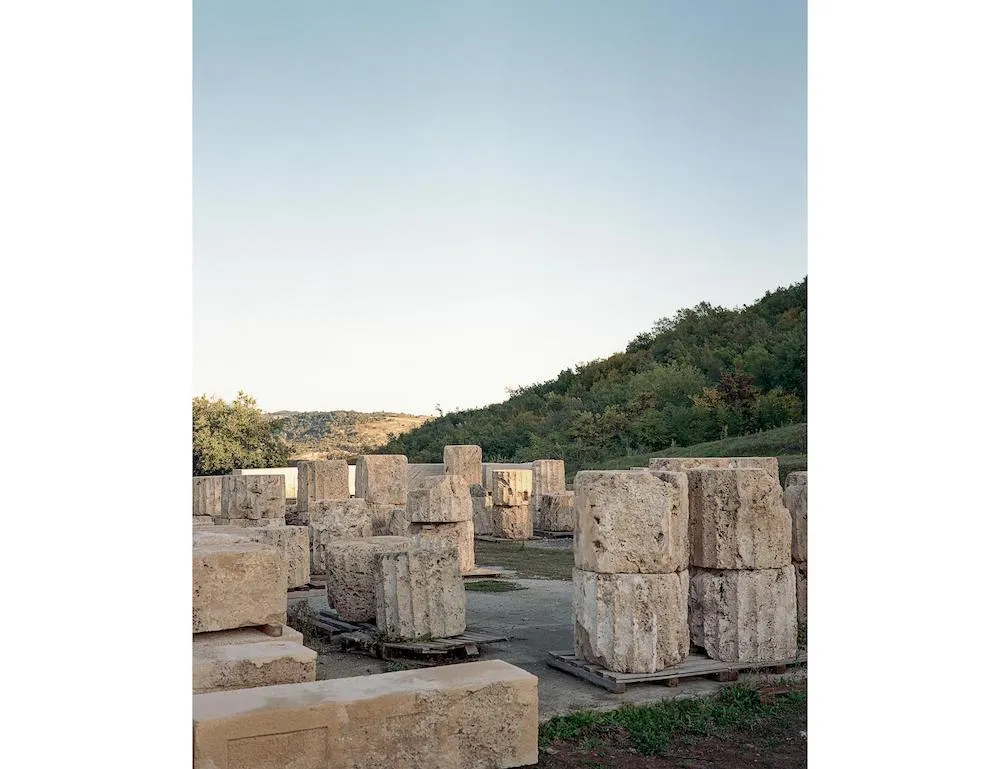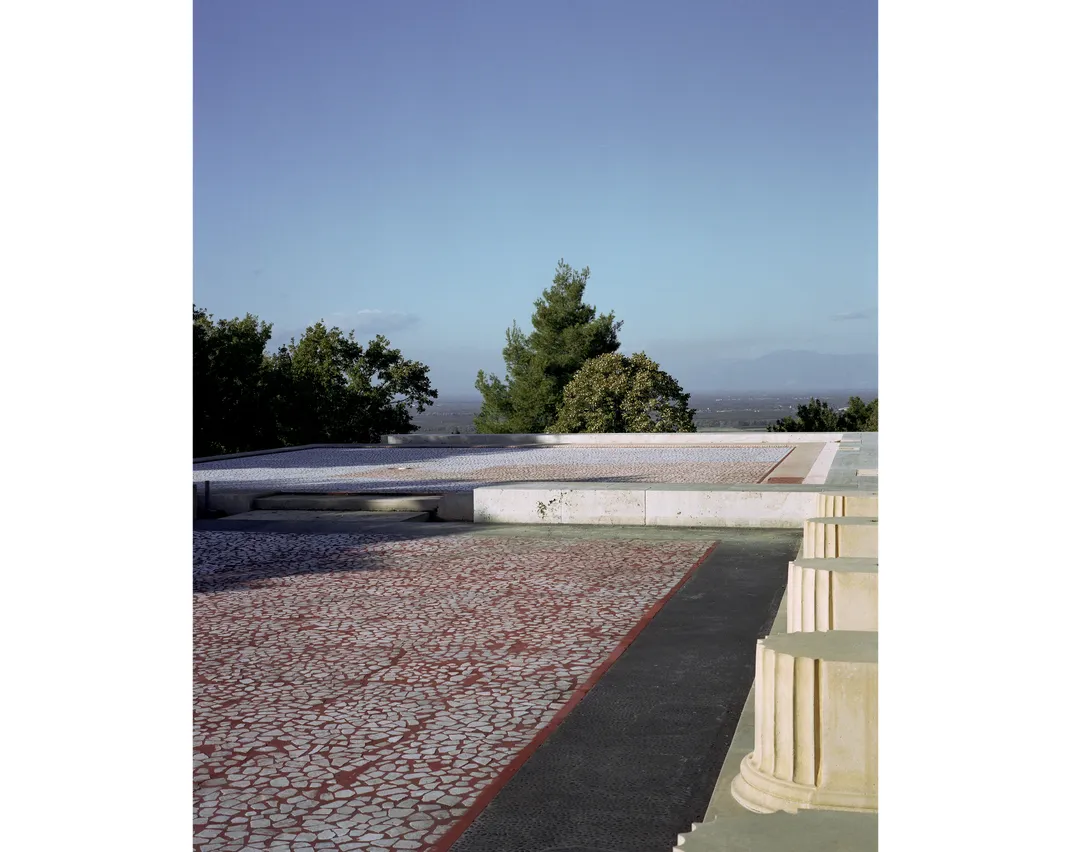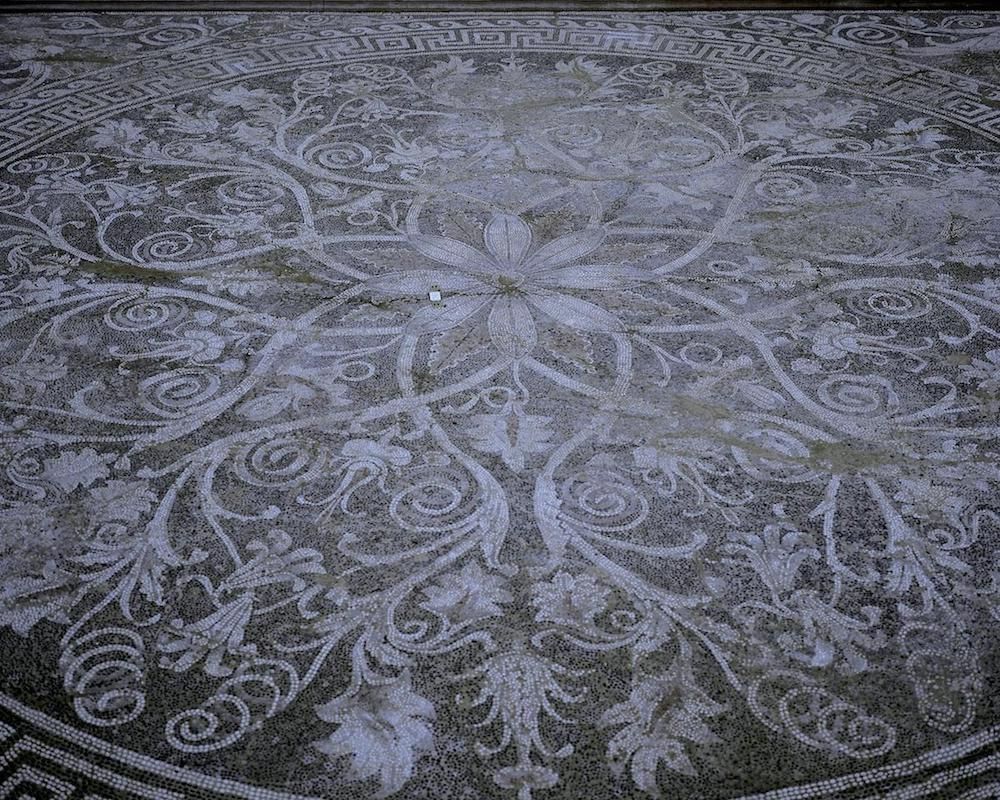I drive on a dirt road in Northern Greece through the ruins and spectral presence of a once-great city. Behind it, cloud shadows move across steep, forested mountains. Small birds dart from bushes. Wind combs the grass. Chunks of limestone, quarried more than 23 centuries ago, protrude from the earth. In the passenger seat, talking and gesticulating, is an archaeologist named Angeliki Kottaridi, a slight, forceful woman in her early 60s with bright coppery-dyed hair.
She is the director of operations here at Aigai, the ancient royal capital of Macedonia, now protected by Unesco as one of the most important archaeological sites in Europe. This is where Philip II of Macedon, having conquered nearly all of classical Greece, built his monumental palace in the fourth century B.C. For too long, Philip has been regarded as a minor figure in ancient history, remembered primarily as the father of Alexander the Great. But Philip was a colossus in his own right, a brilliant military leader and politician who transformed Macedonia and built its first empire. At Aigai, it is Philip who looms largest among the ruins, even though the place was vitally important for Alexander too. Excavations have revealed that Philip transformed the ancient city, revolutionized its political culture, and turned it into a symbol of power and ambition.
We pass the worn-down remains of the outdoor theater that Philip built near his palace. This is where he entertained dignitaries from across Greece and the Balkans, and where he ultimately met his death in a shocking public assassination. Kottaridi hopes to start excavating and restoring the theater soon, but this is an extremely busy year at Aigai. She and her team are preparing the exhibits for a massive new museum, scheduled to open to the public in January 2021. It will showcase artifacts found at the site—a selection of more than 6,000 items, spanning 13 centuries. Meanwhile, digging continues in the vast burial grounds and other parts of the city, and a staff of 75 is working to complete a $22 million partial restoration of Philip II’s palace—the largest building in classical Greece, three times the size of the Parthenon in Athens. For Kottaridi, decades of work are coming to fruition, and for anyone interested in Philip and Alexander, Aigai is now a must-see destination.
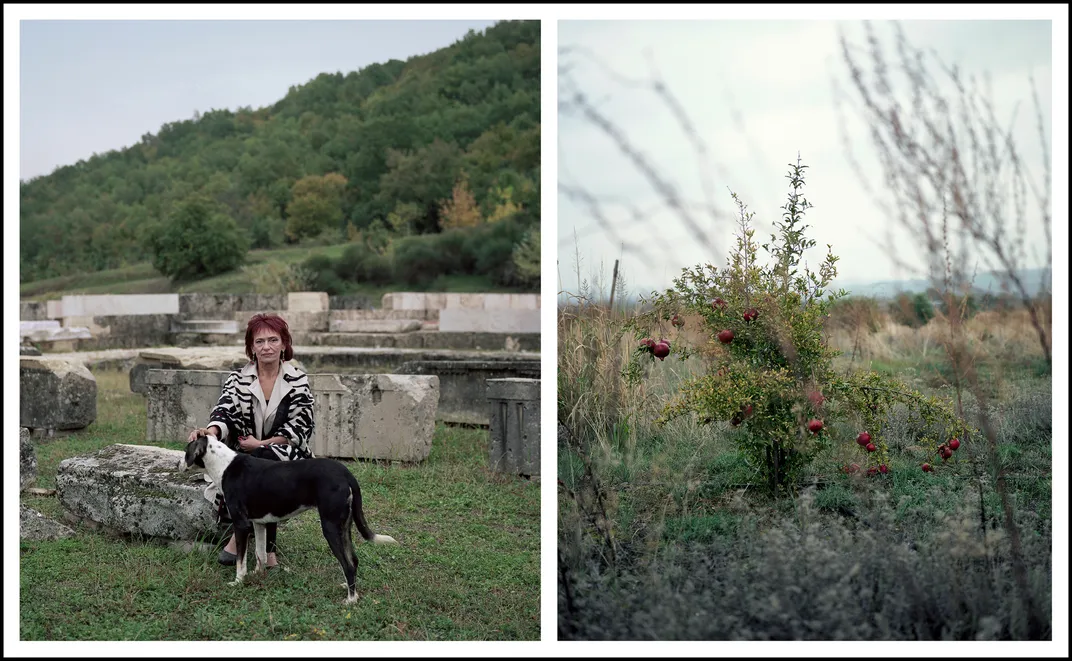
And yet there is so much more to learn. “We have excavated only a tiny portion of the site, less than 1 percent, and this has taken decades,” says Kottaridi. “We are constantly making new discoveries, so many that it’s a problem, because we must also preserve what we have, restore the most important structures, write everything up and present our discoveries to the public. There is enough work for three or four lifetimes.”
Kottaridi grew up in the northern Greek city of Thessaloniki and studied at the Aristotle University there. Now she lives near Aigai in a house that she shares with a rescue dog and a retinue of 30 cats. Kottaridi doesn’t drive, won’t fly, refuses to use a smartphone, ignores most of her email and has planted more than 1,600 trees at Aigai, mainly for the birds. She has published six books and 150 academic papers, and in 2008 she was awarded the prestigious Golden Cross of the Order of the Phoenix by President Karolos Papoulias of Greece for her contributions to knowledge of the ancient world. “People ask why I have no children,” she says. “It’s really because I adopted Alexander the Great. I fell in love with him when I was young—not the mythical figure but the man. He was so much more than a military genius. He opened up the Silk Road. He built these amazing Hellenistic cities in Tajikistan, Afghanistan, Pakistan, Egypt, with freedom of religion, tolerance for different cultures, equal opportunity. And it all began right here in Aigai.”
This is where Alexander launched his famous invasion of the Persian Empire. Without denying Alexander’s greatness, it’s important to remember that he was using his father’s army, and that the expedition was Philip’s idea.
* * *
Kottaridi and her colleagues have found graves and ornamental burial goods dating back perhaps 3,000 years, but Aigai didn’t become a city until the seventh century B.C. That’s when the Temenids, a Macedonian royal dynasty that claimed direct descent from Zeus and Hercules, established their capital here.
According to legend, the first Temenid king, Perdiccas, was told by the oracle at Delphi that a herd of white goats would lead him to the site of his kingdom’s capital. Perdiccas followed the goats to the foothills of the Pierian Mountains, overlooking the Haliacmon River as it crosses the wide green Macedonian plain. “The word aigai means ‘goats’ in ancient Greek,” says Kottaridi, as we admire the same view.
The culture of the ancient Macedonian people, who originated as herding and hunting tribes north of Mount Olympus, became more Greek under Temenid rule. They spoke a dialect of the Greek language and worshiped Greek gods. “One of the important discoveries at Aigai was the tombstone carvings,” says Kottaridi. “They taught us that everyone here had Greek names. They thought of themselves as Macedonians and Greeks.”
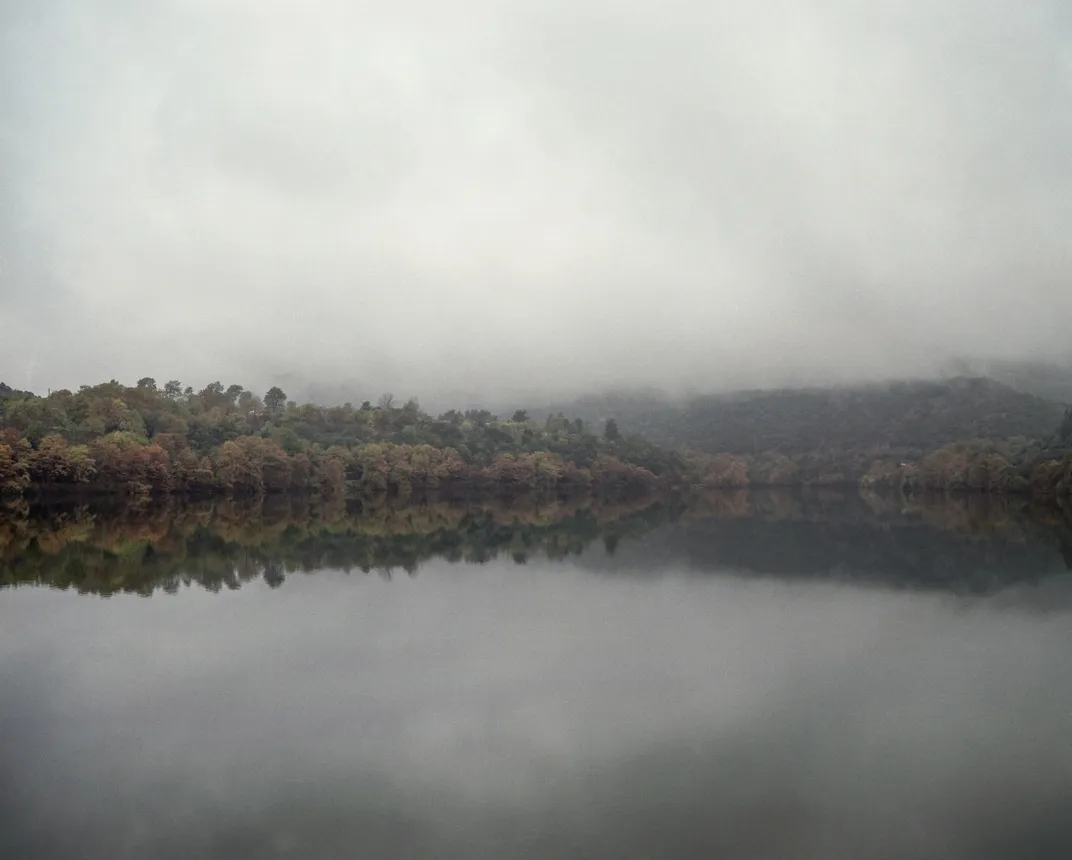
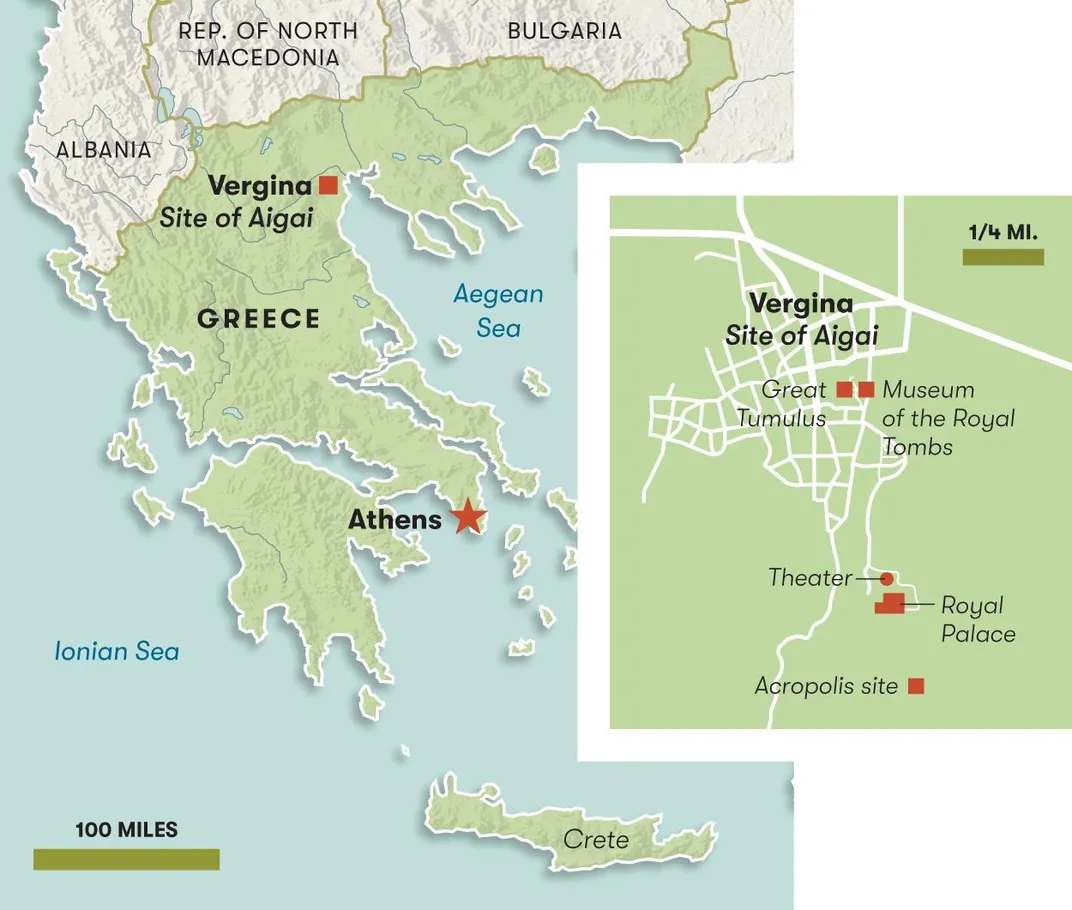
In the eyes of sophisticated Athenians, however, they were northern barbarians who mangled the language, practiced polygamy, guzzled their wine without diluting it, and were more likely to brawl at the symposium than to discuss the finer points of art and philosophy. The Athenian politician Demosthenes once described Philip II as “a miserable Macedonian, from a land from which previously you could not even buy a decent slave.”
When Philip was growing up at the Macedonian court—based at the administrative capital of Pella, with Aigai reserved for royal weddings, funerals and other ceremonial occasions—he learned to hunt, ride and fight in combat. He also studied Greek philosophy, drama and poetry, and absorbed the necessity for ruthlessness in politics. The palace was a viper’s nest of treachery and ambition, and royal children were frequently murdered by rivals to the throne. Macedonia was a violent, unstable, hypermasculine society surrounded by enemies.
In 359 B.C., Philip, 23, saw his older brother King Perdiccas III and 4,000 men get slaughtered by the Illyrians, a rebellious warlike people in Upper Macedonia. His other brother had been murdered in a palace conspiracy, and since Perdiccas III’s heir was a small child, the Macedonian Assembly appointed Philip as regent to the throne, and then as king. “He inherited a very old-fashioned tribal kingdom, with an economy based on livestock,” says Kottaridi. “Philip had lived in Thebes for a few years, and he brought new ideas from Greece. He introduced coinage. He turned this city into a politically functioning space, and he completely revolutionized the military.”
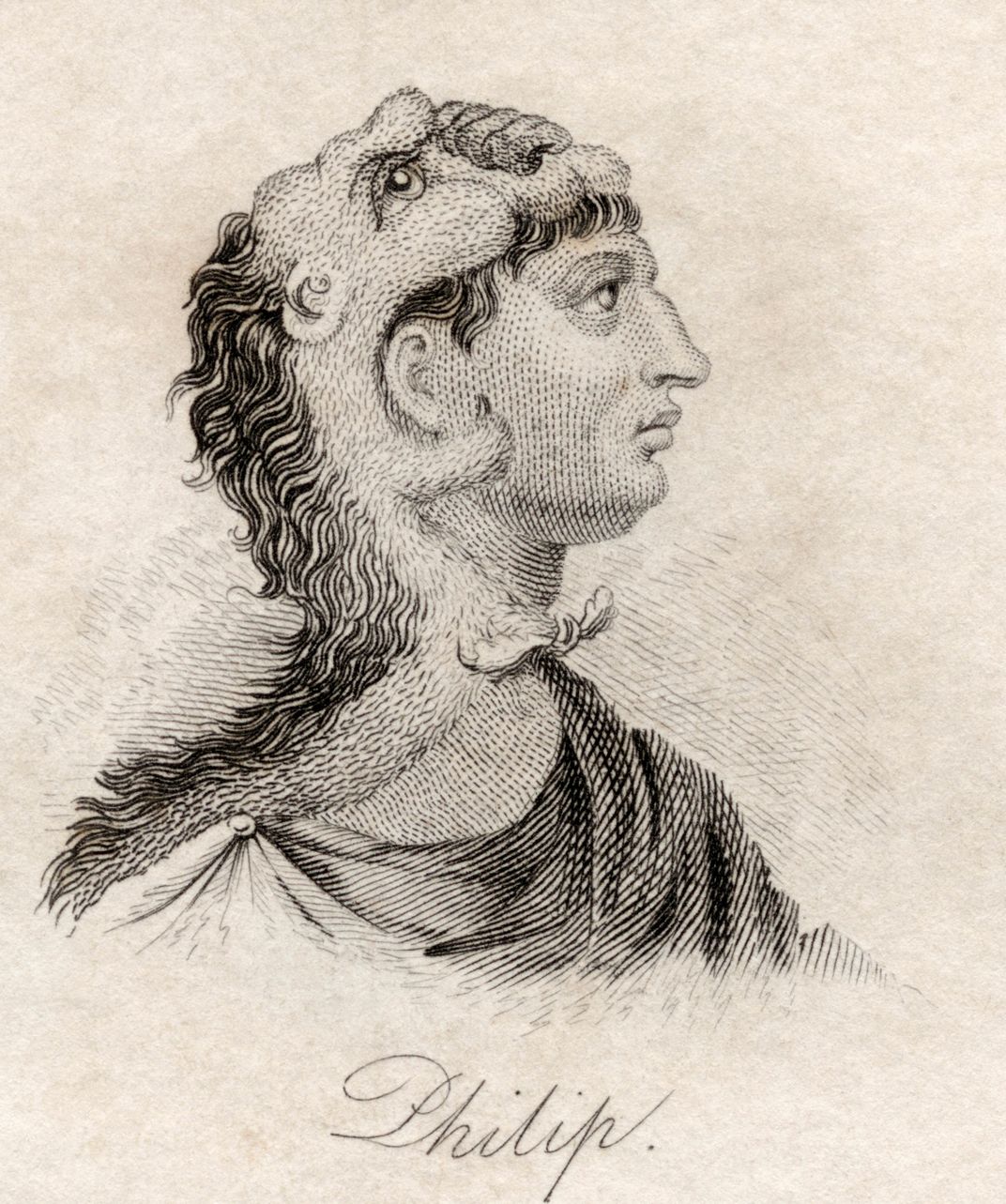
Macedonia had no full-time professional soldiers, just conscripts and volunteers. Philip instituted regular pay, better training and weapons, a promotion pathway, and a system of cash bonuses and land grants in conquered territories. He invented a highly effective new weapon, the sarissa, a 14- to 18-foot pike with an iron spearhead, and he trained his infantry to fight in a new phalanx formation. Like a traditional Macedonian warrior-king, Philip always led from the front in battle, charging toward the enemy on horseback. In addition to minor wounds, he lost an eye to an arrow, shattered a collarbone, maimed a hand and suffered a near-fatal leg wound, which left him limping for the rest of his life. The Roman historian Plutarch tells us that “he did not cover over or hide his scars, but displayed them openly as symbolic representations, cut into his body, of virtue and courage.”
Philip inherited 10,000 part-time infantrymen and 600 cavalry, and built this up to 24,000 infantry and 3,000 cavalry. None of the city-states in Greece had such large standing armies. Nor did they foresee that Philip would use his military, along with cunning diplomacy and seven strategic marriages, to bring nearly all of Greece, a large swath of the Balkans and part of what is now Turkey under ancient Macedonian rule. “This is an incredible achievement for someone they dismissed as a barbarian, and very important for Alexander,” says Kottaridi.
* * *
Nineteen miles from Aigai, just outside the village of Naoussa, lies a tranquil clearing with caves, springs and ancient carved limestone benches. This is Mieza, or Sanctuary of the Nymphs. When Plutarch came here in the second century A.D., locals told him that this was where Aristotle had tutored the young Alexander. Guidebooks and travel websites impart the same information to modern tourists, and road signs point the way to “Aristotle’s School.”
It is immeasurably intriguing that Alexander, the ancient world’s greatest conqueror, was taught by Aristotle, the great philosopher. How did the experience shape Alexander’s intellect, decision-making, interests and outlook? Would history have run a different course if the young prince had been tutored by someone more ordinary?
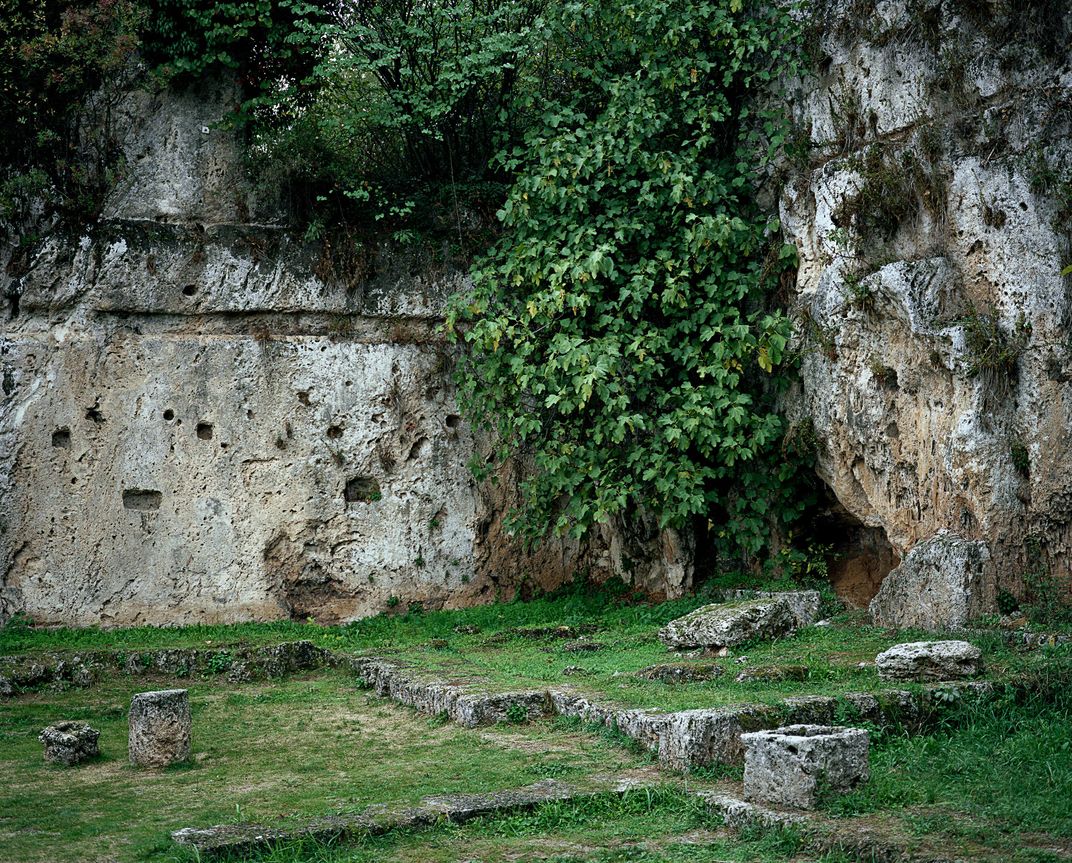
It was Philip’s idea. Alexander, the son of his fourth wife, Olympias, was a bold, headstrong boy of unusual intelligence. When Alexander reached age 13, Philip summoned Aristotle to the Macedonian court. There was a connection between the two families: Aristotle’s father had been a friend and court physician to Philip’s father, Amyntas III. There was also bad blood: Philip had razed Aristotle’s hometown of Stagira six years previously and sold most of its inhabitants into slavery. Nonetheless, the two men came to an agreement. Aristotle would instruct Alexander, and in return Philip would rebuild Stagira and resettle its citizens there.
For the next three years, Aristotle, a curmudgeonly figure who had small eyes, wore many rings and spoke with a lisp, tutored Alexander in biology, ethics, literature, mathematics, medicine, philosophy, politics, rhetoric and zoology. Plutarch describes the two of them sitting on the stone benches and discussing philosophy, and strolling through nearby orchards and vineyards. Modern guidebooks and history books repeat this romantic description, much to Kottaridi’s annoyance.
“It is idiotic!” she says. “From 13 to 16, Alexander and his peers learned how to fight. They would have done this in a gymnasium, a combination of school and military academy, with different areas to sleep, eat, study and fight. There is no evidence of facilities like this at the Mieza sanctuary. There is no room for them!”
In fact, Kottaridi’s colleagues have partially excavated the remains of a gymnasium seven miles away, near an ancient theater, and they have dated it to the time of Philip II. To the displeasure of the villagers in Naoussa, for whom “Aristotle’s School” has constituted a tourist attraction since the second century, local archaeologists now believe that Aristotle taught Alexander and probably 150 other students at this gymnasium. Philip likely built it in order to supercharge his elite warrior class, in preparation for his planned invasion of the Persian Empire.
I visit the place with Ioannes Graekos, an affable archaeologist who used to work at Aigai and now oversees a museum in the nearby town of Veria. There isn’t much to see at the gymnasium site—a few old digs on a large area of overgrown land—because the excavation stalled for lack of funding. Nonetheless, Graekos is able to conjure up what once stood here: a massive two-story building with dining rooms, wrestling and fighting areas, and classrooms. “Alexander and Aristotle probably visited the Mieza sanctuary, because it was so close, and so pleasant, but the real schooling took place here,” he says.
Aristotle’s fascination with nature, and his belief in the scientific method, exerted a strong influence on Alexander, who took naturalists with him as he marched his army across Asia. Alexander apparently sent their reports back to Aristotle, accompanied by flora and fauna samples. He also included scientists, engineers and philosophers in his retinue, and opened up intellectual contacts between East and West. When their student-teacher relationship ended in 340 B.C., Aristotle gave his own, annotated copy of the Iliad to Alexander, who carried the book to Asia and famously placed it under his pillow, next to his dagger, while he slept.
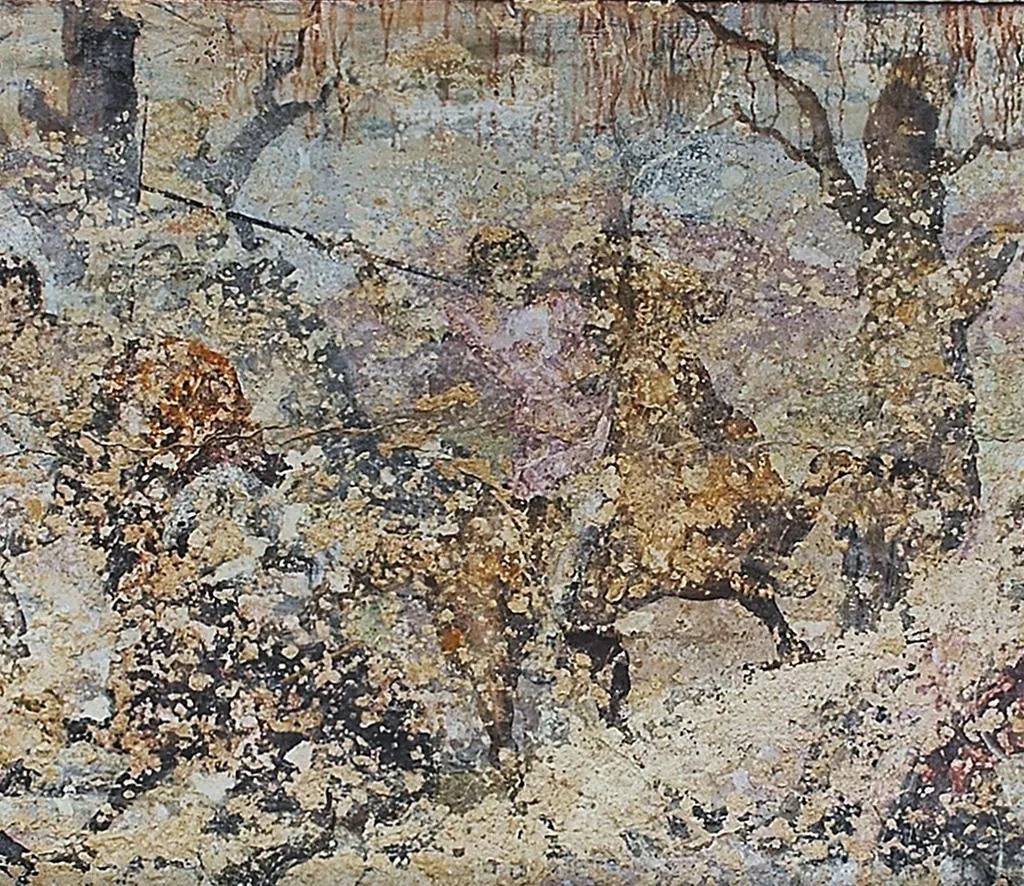
In one important regard, Alexander and Aristotle disagreed. The philosopher thought that all non-Greek people were barbarians and potential slaves. When Alexander started hiring foreigners in his army and administration, the relationship cooled. “Alexander wanted to expand the world and prove what a mixture of people can do and be,” says Graekos. “He wanted citizenship to mean the same thing for his subjects in Afghanistan and Persia as in Macedonia. This was anathema to Aristotle, who advised Alexander to treat people from other nations as you treat plants and animals.”
Anthony Everitt, the British author of the recent biography Alexander the Great, agrees that Aristotle was a hard-core nationalist. Talking by phone, he jokingly compares the philosopher to a “Brexiteer.” But he disagrees with Graekos’ and Kottaridi’s portrayal of Alexander as a pan-ethnic idealist who wanted to bring races and creeds together. “Alexander was driven by the excitement of fighting, which he loved, and the Homeric idea that war brought glory,” he says. “Once he had defeated the Persian Empire, he needed a practical way of governing a vast territory with many different languages. His solution was to hire locals. Gradually this led to the blending of cultures.”
* * *
Angeliki Kottaridi was a 20-year-old archaeology student in 1977 when her professor, Manolis Andronikos, invited her on a dig at Aigai. He had been excavating the tumuli, or burial mounds, near the modern village of Vergina. An English historian, Nicholas Hammond, had suggested that the tumuli and ruined palace belonged to the lost city of Aigai, and Andronikos agreed with him.
After the breakup of the Macedonian kingdom by the Romans in the second century B.C., Aigai fell into decline and obscurity. Then, in the first century A.D., a massive landslide buried the city and consigned it to oblivion, although a large burial mound remained clearly visible at the edge of the plain. Andronikos called it the Great Tumulus, and that’s where he and Kottaridi were digging.
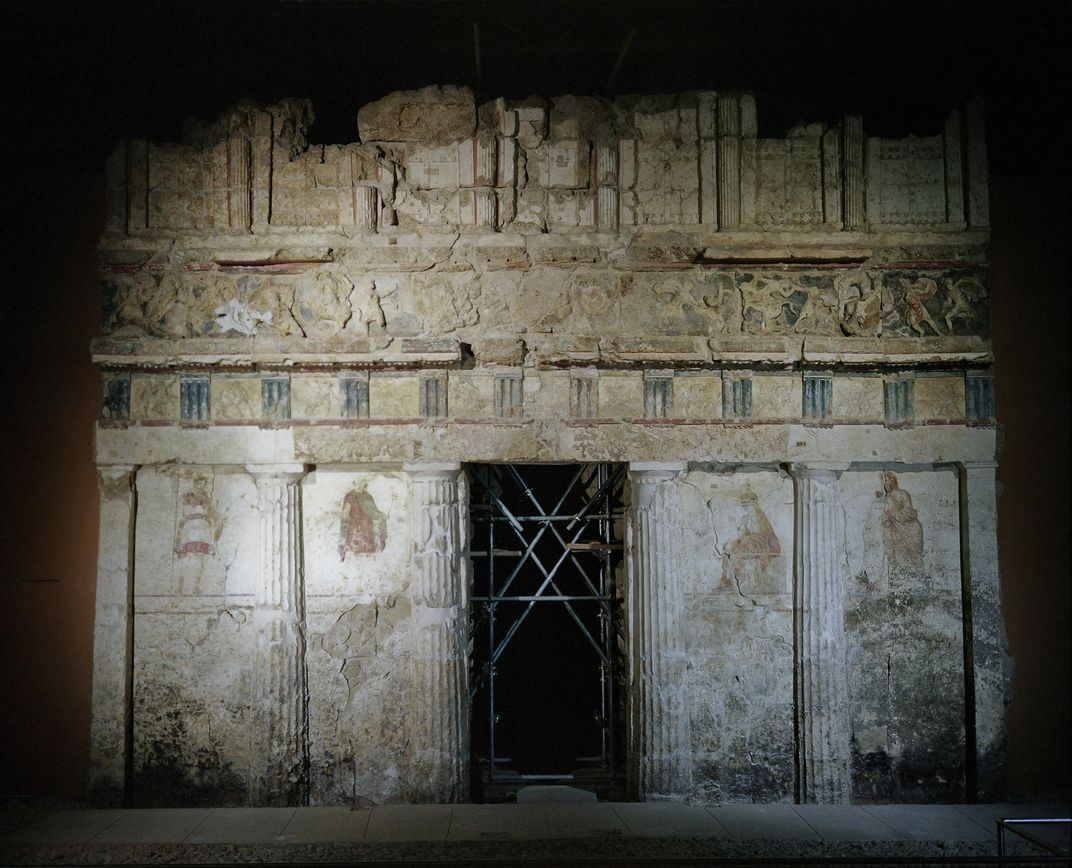
“I was thrilled that he chose me to help, but it was a very ugly excavation,” she says. “Just earth, earth, earth. Nothing but earth for 40 days. Then the miracle.” Excavating 16 feet down with a small hoe, Andronikos uncovered two royal tombs and dated them to the fourth century B.C. Other royal tombs discovered nearby had been looted in antiquity. But these newly unearthed ones were sealed and intact. That night, with guards posted at the dig, the two researchers barely slept.
The following day, they pried open the marble door to the first tomb. They stepped into a large, vaulted, double chamber strewn with smashed pottery, silver vases, bronze vessels, armor and weapons, including a golden breastplate and a beautiful gilded arrow quiver. Painted on one wall was a breathtaking frieze depicting Philip II and a young Alexander, both on horseback, hunting lions and other animals.
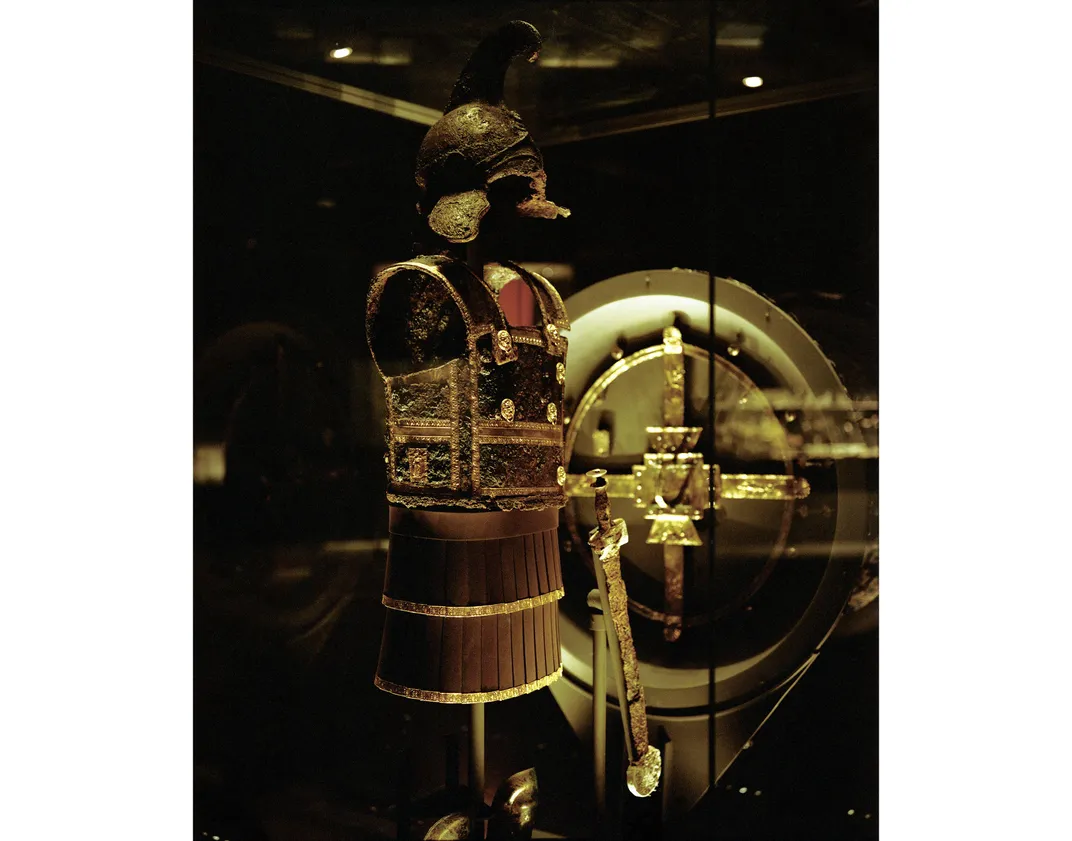
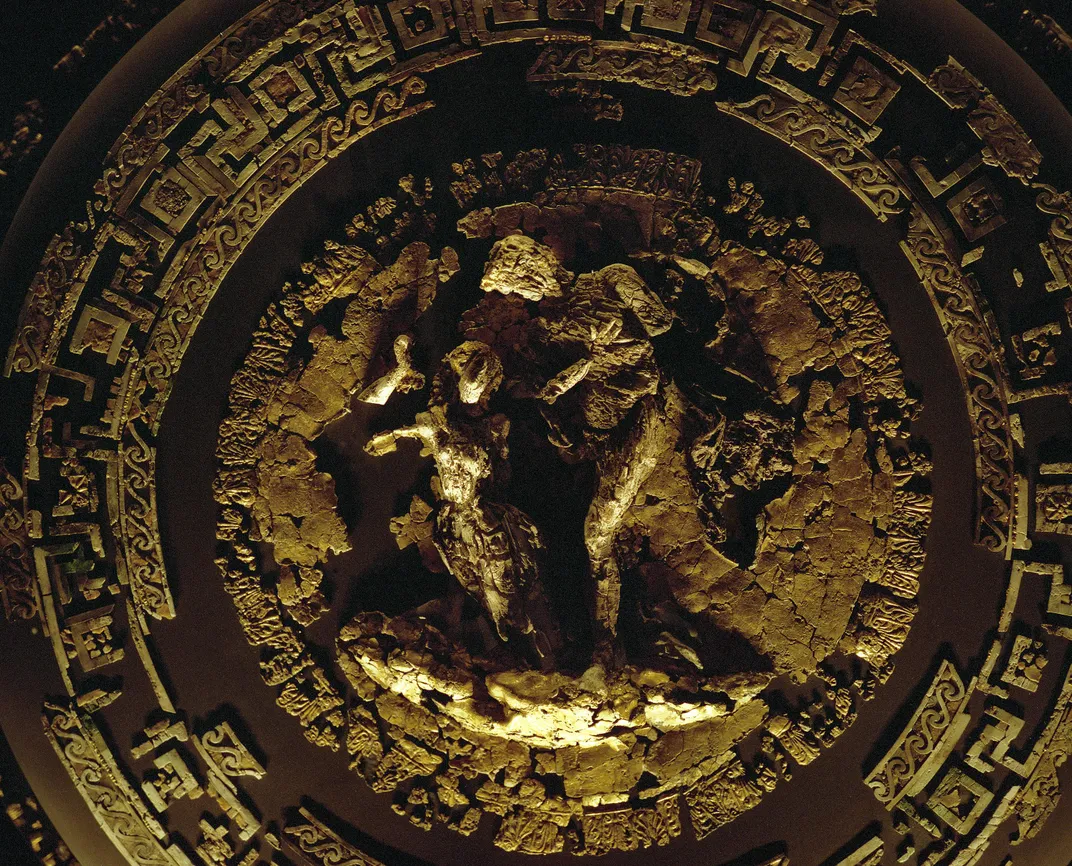
Opening a marble sarcophagus with trembling hands, Andronikos found a small golden coffin, or larnax, with a relief star on the lid. Lifting it, he saw burned bones and a golden wreath. A shiver ran down his spine. He was unable to breathe. If the dating was correct, he was almost certainly holding the bones of Philip II. “It was far too terrifying an idea for my brain to assimilate,” he later wrote.
The discovery, widely reported in the news media, was hailed as the archaeological find of the century. (Some archaeologists have disputed that Philip II’s bones were in the golden larnax, but the latest research, and the weight of professional opinion, now indicates that Andronikos was correct.) The following year, with Kottaridi as his assistant, Andronikos unsealed the unlooted tomb of Alexander IV, the son of Alexander the Great. “I was the first to catalog the items coming out of these tombs, to describe, measure and draw them,” Kottaridi says. “An unbelievable honor.” After finishing her dissertation in 1981, she worked as Andronikos’ assistant until he retired in 1989. Kottaridi took charge of Aigai in 1991 and has been overseeing it ever since.
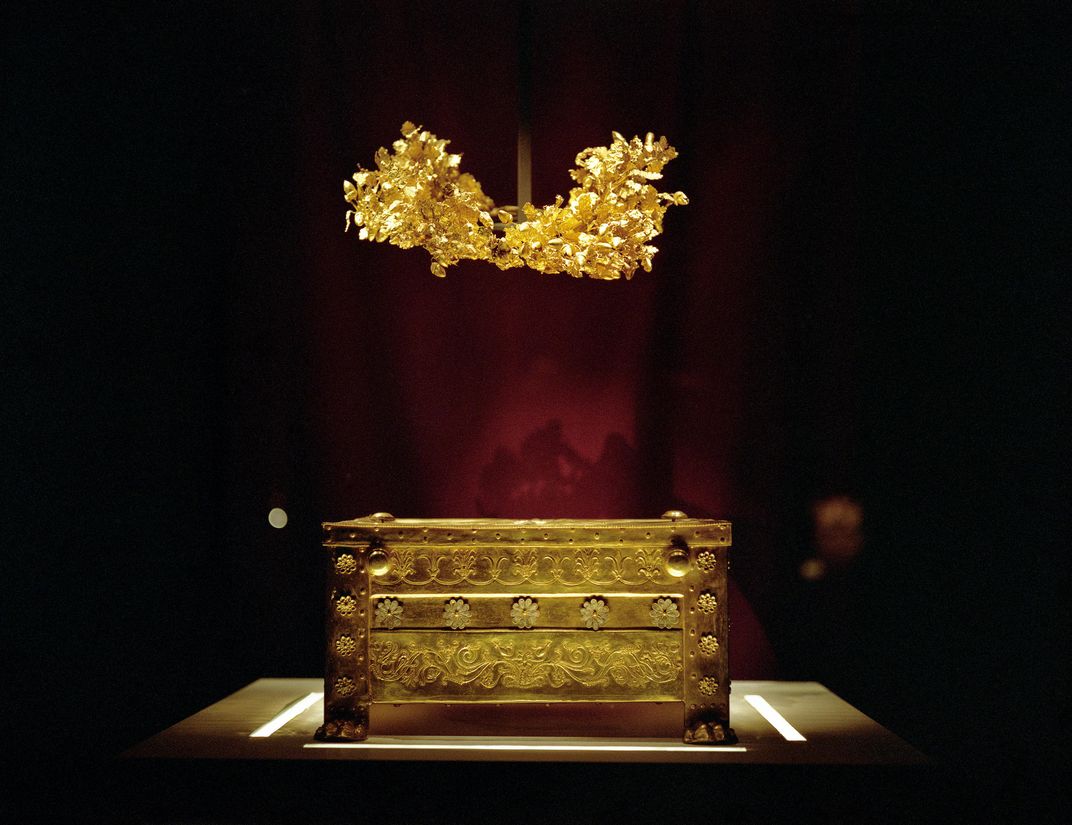
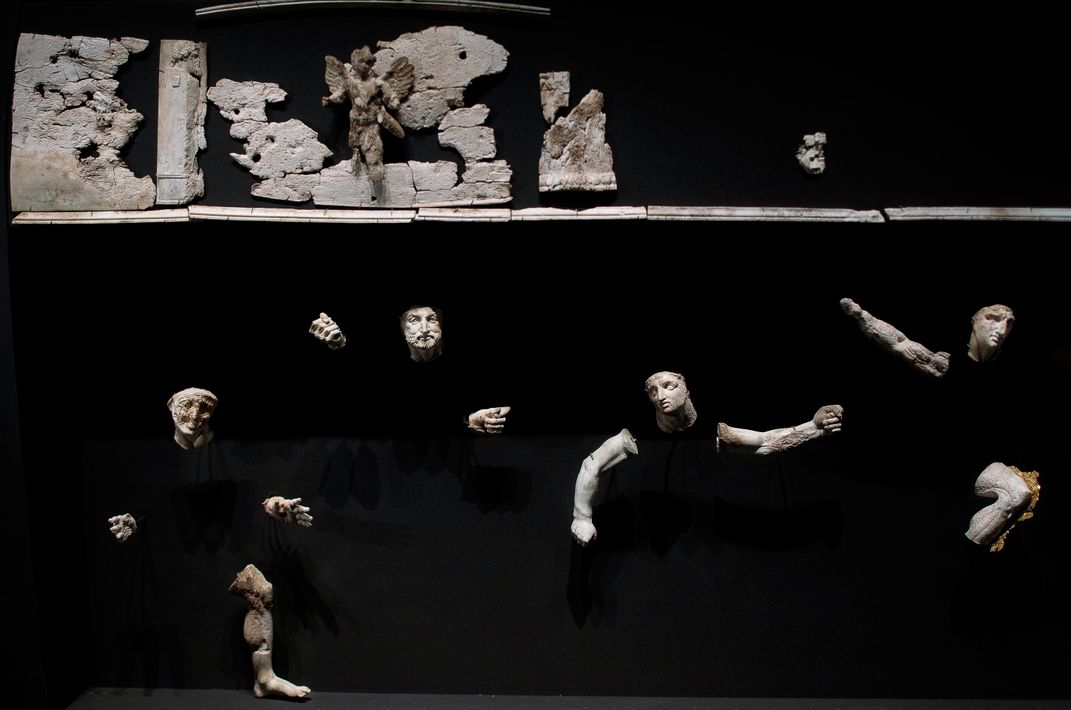
“When Manolis was here, we found the theater, the acropolis on the mountain, and four royal tombs,” she says. “Since I’ve been in charge, we have excavated more than a thousand tombs and found sanctuaries, new city districts, farmhouses, streets, fortifications. We have a much clearer idea of the history and the form of the city. It was spread out with different districts serving different functions.”
Kottaridi’s plan for Aigai is based on the same principle. She has been creating a “Polycentric Museum,” with separate and distinct units scattered over a wide area and integrated with the ongoing archaeology. The Museum of the Royal Tombs, completed in 1993, is a dark, atmospheric, underground space inside the Great Tumulus. Here one can see the tombs, frescoes and spectacular golden grave goods of Philip II, Alexander IV and other kings.
The site of the palace is nearly a mile away, on a broad terrace of land in the foothills. On a quiet Sunday afternoon, with Kottaridi in the passenger seat, I drive up there. Here Philip’s immense structure, under restoration by Kottaridi, is rising for the second time. The peristyle, or main courtyard, is 130,000 square feet—room for 8,000 people to gather. “This was a political building, not a home, and it was open to the public,” she says. “It was a place for feasts, political meetings, philosophical discussions, with banqueting rooms on the second floor and a library. The peristyle was flanked by stone colonnades, which we are restoring to a height of six meters. We are redoing all the mosaics on the floor. It is very difficult to find stonemasons and mosaic-makers who can do this work by hand.”
The great palace, “utterly revolutionary and avant-garde for its time,” Kottaridi says, was two stories high and visible from the entire Macedonian basin. It was a symbol of Philip’s power and sophistication, a reflection of his ambition, and a retort to the Athenians who had derided him and were now his subjects.
Colossal Ambition
Philip’s vast royal complex, covering an area of nearly four acres, larger than any monument in Athens, must have reminded his Greek neighbors that his kingdom had defeated them.
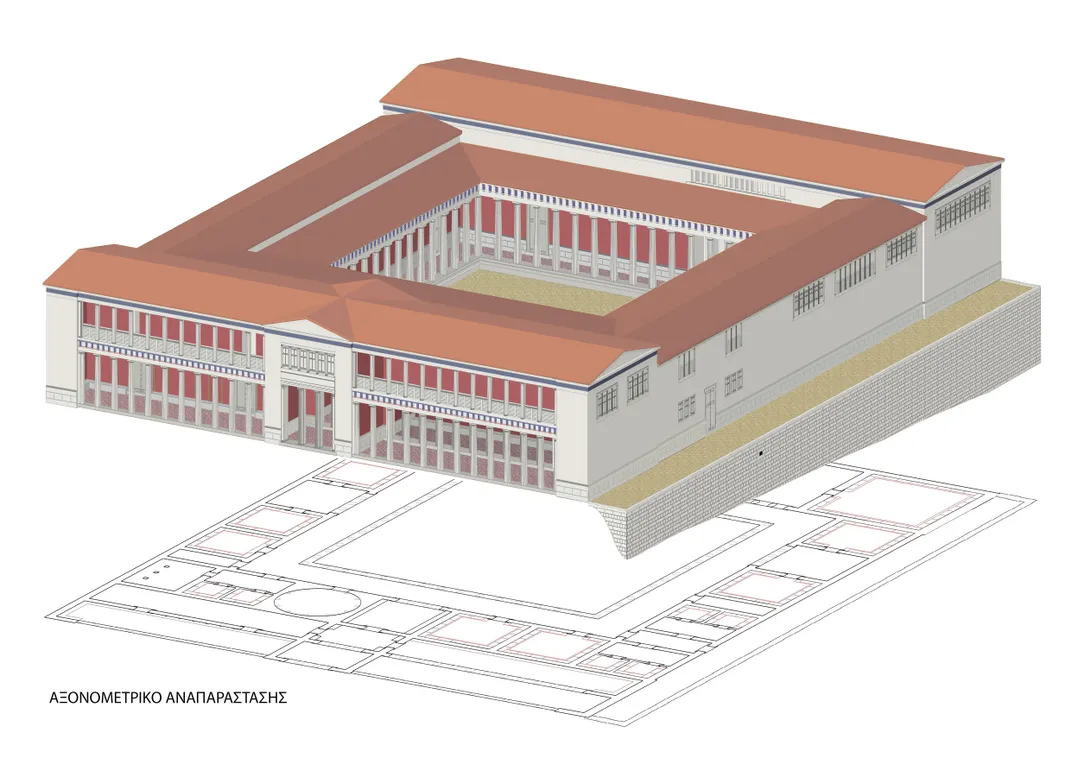
By 336 B.C., after little more than two decades on the throne, Philip had transformed Macedonia from a struggling backwater into an imperial superpower. Now he was planning to invade the Persian Empire in Asia Minor. He had already sent an advance contingent of 10,000 troops. The rest of the army would join them after the marriage of his daughter Cleopatra (no connection with the Egyptian queen) in October. He turned the wedding into a huge gala for dignitaries and ambassadors from all over Greece and the Balkans.
“They crowned Philip with golden wreaths,” says Kottaridi. “The wedding took place right here in the palace and there was a huge feast. The next morning they all gathered at the theater for the final celebration.”
It began with a sunrise procession. Twelve men came through the theater holding up statues of the 12 Olympian gods. They were followed by a statue of Philip, suggesting that he had crossed the permeable line between men and gods and was now divine. Then came one-eyed Philip himself, scarred and limping, but radiating power and authority. He wore a white cloak and a golden crown, and most dramatically, he was unarmed. Macedonian men typically wore their weapons, but Philip wanted to convey his invincibility. When he reached the center of the theater, he stopped and faced the cheering crowd.
Suddenly one of his bodyguards stabbed him in the chest with a dagger, “driving the blow right through the ribs,” according to the historian Diodorus. Philip fell dead and his white cloak turned red. The assassin sprinted to the city gates, where horses were waiting for him. Three bodyguards who were friends of Alexander gave chase, caught him and killed him on the spot.
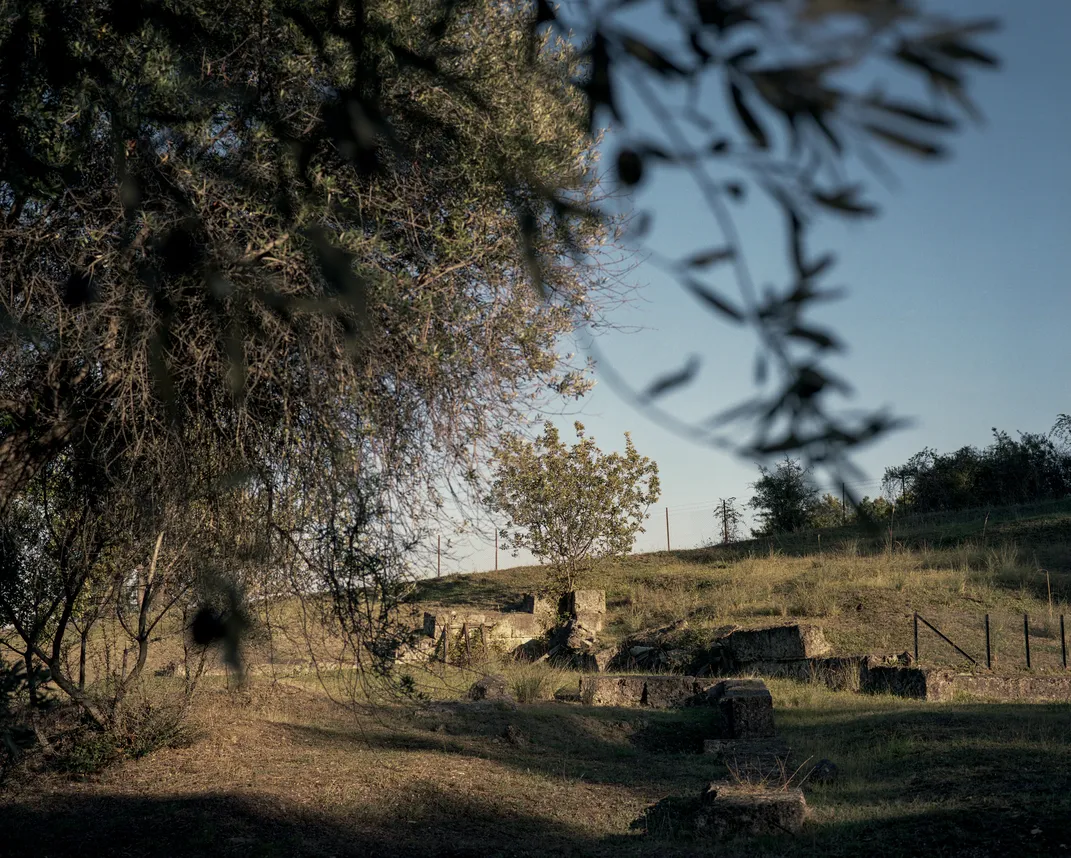
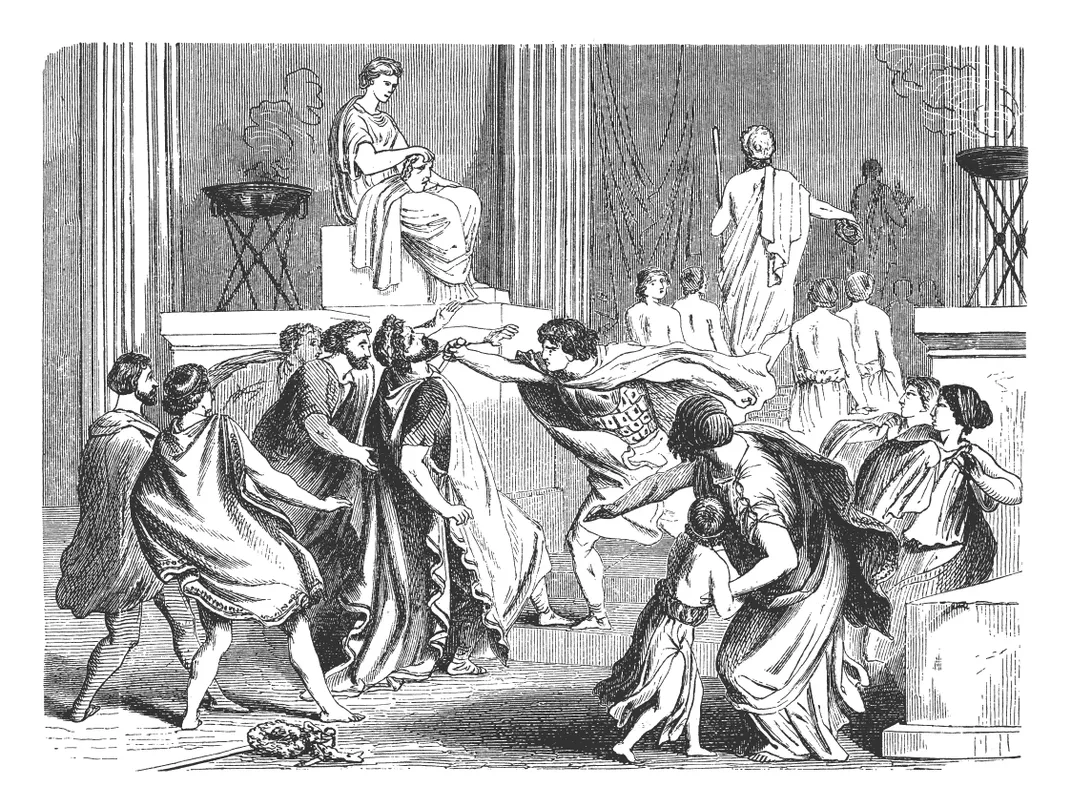
The assassin was Pausanias of Orestes in Upper Macedonia, and Philip had recently jilted him for a new male lover. Pausanias was then gang-raped by a man named Attalus and his cronies, and turned over to the stable hands for more sexual abuse. When Pausanias reported this outrage to Philip, the king did nothing. Did Pausanias murder Philip for not punishing Attalus, as some scholars believe? Or was Pausanias the paid instrument of more powerful individuals who wanted Philip dead, as other scholars believe?
We know that Olympias loathed her husband and yearned for Alexander to take the throne. King Darius II of Persia is another suspect with an obvious motive: Philip was preparing to invade his empire. Prominent Athenians are under suspicion, because they resented Macedonian rule. The finger has also been pointed at Alexander, who had quarreled with his father and would gain the throne with his death.
That last theory is a foolish slander against Alexander, Kottaridi says. She suspects a plot by a rival faction of nobles. Palace intrigues had long been a blood sport in Macedonia. The kings at Aigai—Philip was 46—almost never died of old age.
* * *
The semicircular theater is a short distance from the palace and was built as part of the same complex. For Kottaridi, it is a place of the greatest historical significance, and she yearns to restore it. Standing in the wind, gazing at the grassed-over ruins, she describes the aftermath of Philip’s murder, the chaos and panic, 19-year-old Alexander and his supporters marching up from the theater into the palace, where Alexander swiftly gained the support of the generals and was declared king.
She sighs and dabs tears from her eyes. “This is the very place where, in one moment, the history of the world changed for all eternity.”
Alexander threw the biggest funeral in Macedonian history for his father. After burning the body on a pyre, attendants retrieved the bones, washed them in wine, wrapped them in purple cloth and laid them in a golden larnax. The larnax was then placed in a sarcophagus and the tomb was sealed.
Alexander, facing a revolt in Greece, marched out to crush it, and when he returned to Aigai a year later he threw a party. He invited many of the same dignitaries who had attended Cleopatra’s wedding, and he presented a nine-day drama at the theater where they had witnessed his father’s murder. After the celebrations, he launched his invasion of the Persian Empire, carrying out his father’s plan with his father’s army, siege machinery and many of the same generals. Although Alexander was a brilliant commander, and his campaign in Asia would far exceed anything that Philip had imagined, it was his inheritance that made it possible. Without Philip’s war machine, there would have been no Alexander the Great.
/https://tf-cmsv2-smithsonianmag-media.s3.amazonaws.com/filer/1f/61/1f610397-525a-43bb-949e-c8b7ddc1e2a6/mobileopener-macedonia.jpg)
/https://tf-cmsv2-smithsonianmag-media.s3.amazonaws.com/filer/a3/16/a316ce21-07d7-4297-aee4-3f4ee15ddaaf/opener2000x675_opener.jpg)
